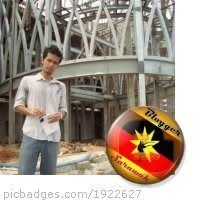Archive for 10/01/2009 - 11/01/2009
Architect : HyoMan Kim
Location : Gapyunggun, Gyeounggi-do, Korea
Design team : SuMi Jung, JungMin Oh, ARum Kim, SunHee Kim
Structure designer : MOA. SungYeong Oh
Lighting designer : LITEWORK, Seoda
Furniture designer : HeeSu Hong – Seoda
Contractor : JEHYO
Site area : 872.63 sqm
Bldg. area : 337.33 sqm
Gross floor area : 628.02 sqm
Photographer : JongOh Kim
The inner court where is filled with the water and flower and fruit, and the whole of the roof gardens are circulated as the continuous landscape place and that is the place as “architectural nature” in concept.
The huge panoramic view framed with sloped ceiling line that is composed with the lines of stepped roof gardens and the bottom line of the inner court, is the major impression of inner space of this house.
Promenade inner space of skipfloor made the promenade roofgarden-space of skipfloor.
Skip floor plan of inside of this house produced various dramatic spaces.
Floating boxes with bamboo garden – Dynamic, unrealistic sequence of interior space.
As “The architectural nature”, floating white polyhedral masses that have the built-in bamboo gardens, produced the various stories of vertical space
Location : Gapyunggun, Gyeounggi-do, Korea
Design team : SuMi Jung, JungMin Oh, ARum Kim, SunHee Kim
Structure designer : MOA. SungYeong Oh
Lighting designer : LITEWORK, Seoda
Furniture designer : HeeSu Hong – Seoda
Contractor : JEHYO
Site area : 872.63 sqm
Bldg. area : 337.33 sqm
Gross floor area : 628.02 sqm
Photographer : JongOh Kim
This site, where is floating on river and confronted the graceful landscape, was strongly recognized to me as a part of nature, from the first time that I met.
From then, I started to visualize “the architectural nature” as a place of recreation.
Form of site = Form of architecture = Maximum efficiency of landuse
While maximizing the efficiency of landuse, the leaner concrete mass, that cherishes the courtyard where is filled with the water and the greenery, was laid out on this site along the irregular formed site line.
This courtyard is “The architectural nature” and a central recreation space as extended river that communicate the river and architecture.
Continuous circulation of stepped roof garden – Creation of new green land in this site
The whole part of the step typed roofs, where is moving upward with various level, are directly linked to the bed rooms in upper floor.
Finally, this stepped roof gardens are linked to both sides of the inner court at where swimming pool is.
Sucking in dynamic-surrounding landscape
Naturally, all of the rooms inside this site-shaped-mass are laid toward the picturesque landscape to enjoy the graceful scenery surrounded this site.The huge panoramic view framed with sloped ceiling line that is composed with the lines of stepped roof gardens and the bottom line of the inner court, is the major impression of inner space of this house.
Promenade inner space of skipfloor made the promenade roofgarden-space of skipfloor.
Floating boxes with bamboo garden – Dynamic, unrealistic sequence of interior space.
As “The architectural nature”, floating white polyhedral masses that have the built-in bamboo gardens, produced the various stories of vertical space
Landscape architecture – Harmonizing with the surrounding landscape
The shape of the mountain type composed of irregular polygonal shaped concrete mass and metal mesh was designed to harmonize with the context as “the architectural mountain”.
There was the intention to be a part of the surrounding context that consisted of the river and the mountain.
Architectural Island – Island House
As a result, this house was to be “The island house” as an “architectural island”
Aaron J. Greenspan says that while he was a student at Harvard, he came up with the idea for Facebook, the social-networking Web site.
Three Harvard classmates, the founders of ConnectU, have long claimed that Mr. Zuckerberg stole the idea from them, and they are suing him in Federal District Court in Boston.
Both parties seem to have forgotten Aaron J. Greenspan, yet another Harvard classmate. He says he was actually the one who created the original college social networking system, before either side in the legal dispute. And he has the e-mail messages to show it.
As a Harvard student in 2003 — six months before Facebook started and eight months before ConnectU went online — Mr. Greenspan established a simple Web service that he called houseSYSTEM. It was used by several thousand Harvard students for a variety of online college-related tasks. Mr. Zuckerberg was briefly an early participant.
An e-mail message, circulated widely by Mr. Greenspan to Harvard students on Sept. 19, 2003, describes the newest feature of houseSYSTEM, as “the Face Book,” an online system for quickly locating other students. The date was four months before Mr. Zuckerberg started his own site, originally “thefacebook.cm” (Mr. Greenspan retained his college e-mail messages and provided The New York Time with copies of his communications with Mr. Zuckerberg.)
Later the two students exchanged e-mail about their separate projects. When Mr. Greenspan asked what Mr. Zuckerberg was planning and suggested the two integrate their systems, Mr. Zuckerberg responded, a month before starting his own service: “I actually did think about integrating it into houseSYSTEM before you even suggested it, but I decided that it’s probably best to keep them separated at least for now.”
Despite Mr. Greenspan’s entrepreneurial ambitions, Mr. Zuckerberg was the first to move to Silicon Valley, raising venture capital and eventually transforming Facebook from a social networking site for college students into one of the fastest growing Internet sites for both social and business contacts.
Indeed, Mr. Greenspan, who is now 24 and moved to Silicon Valley last year to start a company, appears to be a clear example of a truism in this high-technology region: establishing who is first with an idea is often a murky endeavor at best, and frequently it is not the inventor of an idea who is the ultimate winner.
Mr. Zuckerberg declined to be interviewed, saying through a spokeswoman that he was not sure how to respond. He did not dispute the chronology of events or the authenticity of Mr. Greenspan’s e-mail messages. Mr. Zuckerberg is seeking to dismiss the ConnectU suit.
Mr. Greenspan said that Mr. Zuckerberg’s lawyer contacted him this year in connection with the ConnectU lawsuit but that he had declined a request to serve as a witness, fearing that he would become embroiled in the legal battle.
In an interview at a cafe here this week, Mr. Greenspan said he had mostly made peace with the fact that Mr. Zuckerberg will be the first of his classmates to become a billionaire.
Mark E. Zuckerberg, the chief executive of Facebook.
If Mr. Zuckerberg did borrow some of Mr. Greenspan’s concepts, he may have simply been working in a grand Harvard tradition. After all, it was a young Harvard dropout, Bill Gates, and his classmate, Paul G. Allen, who almost three decades earlier copied a version of the BASIC programming language, designed by two Dartmouth college professors, to jump-start the company that would grow into the world’s most powerful software firm.
“I’ve had a long time to think about this, and I’m not as bitter as I was a year ago,” Mr. Greenspan said. “Things like this aren’t surprising to me anymore.”
Still, he does not seem to be entirely at peace with the way things have turned out, and he wants to have the last word.
He has described the original creation of houseSYSTEM, ConnectU and Facebook in “Authoritas: One Student’s Harvard Admissions,” a 306-page unpublished autobiography about his adventures as a college student.
“This book is partly a search for justice,” he wrote in the introduction. “You don’t write an autobiography in your early 20s unless there’s something you need to get off your chest.”
In “Authoritas,” he described his collision with Harvard authorities when he first started his system. He also explained his frustration in getting the student paper, The Harvard Crimson, to write about houseSYSTEM, which was then being used by about 100 students.
Mr. Zuckerberg, by way of contrast, had no difficulty attracting the interest of the paper, Mr. Greenspan said. It wrote about him first because he had developed MP3-playing software, called Synapse, as a high school student. The paper then published frequent follow-up articles.
College classmates describe Mr. Greenspan as extremely bright and an unusually productive software designer. Mr. Greenspan and Mr. Zuckerberg had much in common, said William Most, who was a classmate. “They were both computer guys and self-starters.”
 Tyler, left, and Cameron Winklevoss, two of the co-founders of ConnectU, say they originated the idea behind Facebook.
Tyler, left, and Cameron Winklevoss, two of the co-founders of ConnectU, say they originated the idea behind Facebook.Although he has yet to find a publisher, he has deployed his system as a commercial Web service for other potential authors as part of CommonRoom, a social networking and business Web site that he established last year.
He attained brief notoriety on several Internet news sites last year when he published an open letter to Mr. Zuckerberg after reports surfaced that Yahoo had offered his college classmate $900 million for Facebook just two years after the founding of the company.
With barely hidden bitterness, he wrote: “Remember the Web site you signed up for at Harvard two days before we met in January, 2004, called houseSYSTEM — the one I made with the Universal Face Book that predated your site by four months?
“Well, I’ve relaunched it as CommonRoom,” he continued, “and just like its predecessor, it has all sorts of features that might seem familiar: birthday reminders, an event calendar, RSVPs, how you know someone, photo albums, courses posters.
“After all, when you saw all of those features in houseSYSTEM three years ago, you called them ‘too useful,’ but I stood by them as valuable. Fortunately, even though I shut down houseSYSTEM, I can still use those same features on Facebook — and I didn’t even have to write any more code!”
Although CommonRoom has just 1,500 users, compared with Facebook’s 37 million, Mr. Greenspan has not given up on the idea of social networking. He is starting his second company — he founded his first, Think Computer, when he was 15 — with a new partner. He said he has been promised venture capital backing for the new company, Qubescape.
“I’ve been doing consulting and software for business for several years now, and I’ve noticed the same problems again and again in business,” he said. “I think there’s a fairly good chance we’ll turn business software on its head.”
Mr. Greenspan says that he has learned some important lessons since leaving school, although he has no love for the thought of becoming one of the serial entrepreneurs common in Silicon Valley.
“I’ve written a lot about Harvard’s motto being ‘veritas,’ ” he wrote recently in an instant message, “and how uncomfortable I was when I discovered that Harvard actually didn’t abide by the ideals of truth at all times. But it’s a good motto. Possibly the best there is, because if you wait long enough, the truth will come out.”
















































